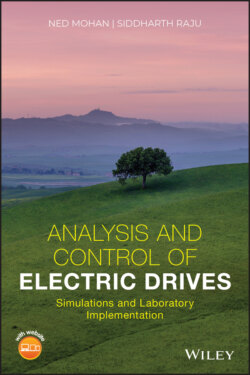Читать книгу Analysis and Control of Electric Drives - Ned Mohan - Страница 29
PROBLEMS
Оглавление1 1‐1. A US Department of Energy report estimates that over 100 billion kWh/year can be saved in the United States by various energy conservation techniques applied to the pump‐driven systems. Calculate (a) how many 1000‐MW generating plants running constantly supply this wasted energy and (b) the annual savings in dollars if the cost of electricity is 0.10$/kWh.
2 1‐2. Visit your local machine‐tool shop and make a list of various electric drive types, applications, and speed/torque ranges.
3 1‐3. Repeat Problem 1-2 for automobiles.
4 1‐4. Repeat Problem 1-2 for household appliances.
5 1‐5. In wind turbines, the ratio (Pshaft/Pwind) of the power available at the shaft to the power in the wind is called the coefficient of performance, Cp, which is a unit‐less quantity. For informational purpose, the plot of this coefficient, as a function of λ, is shown in Fig. P1-5 [6] for various values of the blades pitch‐angle θ, where λ is a constant times the ratio of the blade‐tip speed and the wind speed.The rated power is produced at the wind speed of 12 m/s where the rotational speed of the blades is 20 rpm. The cut‐in wind speed is 4 m/s. Calculate the range over which the blade speed should be varied, between the cut‐in and the rated wind speeds, to harness the maximum power from the wind. In this range of wind speeds, the blade’s pitch‐angle θ is kept at nearly zero. Note: this simple problem shows the benefit of varying the speed of wind turbines, by means of a variable‐speed drive, for maximizing the harnessed energy.Fig. P1-5 Plot of Cp as a function of λ [6].
6 1‐6. Read the report in Appendix 1‐A in the accompanying website “Adaptive Torque Control of Variable Speed Wind Turbines” by Kathryn E. Johnson, National Renewable Energy Laboratory [7].
7 1‐7. In wind turbines, describe the Standard Region 2 Control and describe how it works in your own words.
8 1‐8. Read the report in Appendix 1‐B in the accompanying website “Final Report on Assessment of Motor Technologies for Traction Drives of Hybrid and Electric Vehicles” and answer the following questions for HEV/EV applications:What are the types of machines considered?What type of motor is the most popular choice?What are the alternatives if NdFeB magnets are not available?What are the advantages and disadvantages of SR motors?
9 1‐9. Read the report in Appendix 1‐C in the accompanying website “Evaluation of the 2010 Toyota Prius Hybrid Synergy Drive System” and answer the following questions:What are ECVT, P, CU, and ICE?What type of motor is used in this application?
10 1‐10. Read the report in Appendix 1‐D and summarize the possibility of using SR motors in HEV/EV applications.
